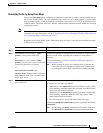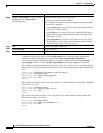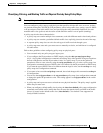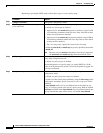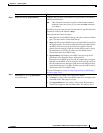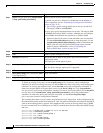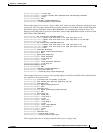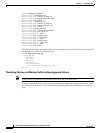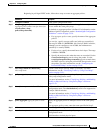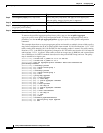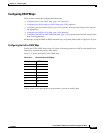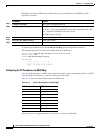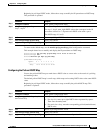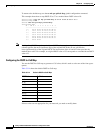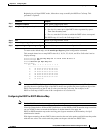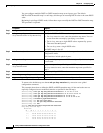
33-59
Catalyst 2960 and 2960-S Switch Software Configuration Guide
OL-8603-09
Chapter 33 Configuring QoS
Configuring Standard QoS
Beginning in privileged EXEC mode, follow these steps to create an aggregate policer:
Command Purpose
Step 1
configure terminal Enter global configuration mode.
Step 2
mls qos aggregate-policer
aggregate-policer-name rate-bps burst-byte
exceed-action {drop |
policed-dscp-transmit}
Define the policer parameters that can be applied to multiple traffic
classes within the same policy map.
By default, no aggregate policer is defined. For information on the
number of policers supported, see the “Standard QoS Configuration
Guidelines” section on page 33-38.
• For aggregate-policer-name, specify the name of the aggregate
policer.
For rate-bps, specify average traffic rate in bits per second (b/s).
The range is 8000 to 10000000000. (On Catalyst 2960-S switches,
although you can configure a rate of 8000, the minimum rate
granularity is actually 16000.)
• For burst-byte, specify the normal burst size in bytes. The range
is 8000 to 1000000.
• Specify the action to take when the rates are exceeded. Use the
exceed-action drop keywords to drop the packet. Use the
exceed-action policed-dscp-transmit keywords to mark down
the DSCP value (by using the policed-DSCP map) and to send
the packet. For more information, see the “Configuring the
Policed-DSCP Map” section on page 33-63.
Step 3
class-map [match-all | match-any]
class-map-name
Create a class map to classify traffic as necessary. For more
information, see the “Classifying Traffic by Using Class Maps”
section on page 33-51.
Step 4
policy-map policy-map-name Create a policy map by entering the policy map name, and enter
policy-map configuration mode.
For more information, see the “Classifying, Policing, and Marking
Traffic on Physical Ports by Using Policy Maps” section on
page 33-53.
Step 5
class [class-map-name | class-default] Define a traffic classification, and enter policy-map class
configuration mode. The class-default keyword is not supported on
Catalyst 2960-S switches.
For more information, see the “Classifying, Policing, and Marking
Traffic on Physical Ports by Using Policy Maps” section on
page 33-53.
Step 6
police aggregate aggregate-policer-name Apply an aggregate policer to multiple classes in the same policy
map.
For aggregate-policer-name, enter the name specified in Step 2.
Step 7
exit Return to global configuration mode.
Step 8
interface interface-id Specify the port to attach to the policy map, and enter interface
configuration mode.
Valid interfaces include physical ports.



